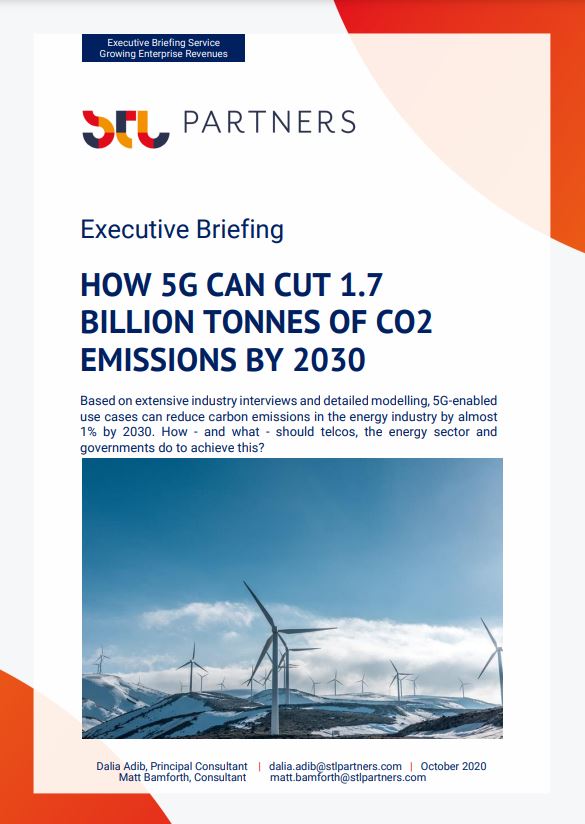Sale!
How 5G can cut 1.7 billion tonnes of CO2 emissions by 2030
£1,000.00 excl VAT
Based on extensive industry interviews and detailed modelling, 5G-enabled use cases can reduce carbon emissions in the energy industry by almost 1% by 2030. How – and what – should telcos, the energy sector and governments do to achieve this?
Note: that the Excel dataset is not included with this product. To purchase access to this dataset get in touch at contact@stlpartners.com
Description
Format: PDF filePages: 41 pagesCharts: 31Author: Dalia Adib, Matt BamforthPublication Date: October 2020
Table of Contents
- Preface
- Executive summary
- 5G can contribute to solving the climate change challenge: Close to 1% reduction of total global emissions in 2030
- Ensuring progress: A call for telecoms, energy and government to cooperate
- How 5G can impact carbon emissions: A result of many use cases, not one killer app
- Introduction: Transitioning towards a carbon-neutral world
- A framework for thinking through the carbon emissions challenge
- Towards a smart grid: The changing energy ecosystem
- A deep-dive into the role of 5G
- Key benefits of 5G in the energy sector
- New use cases and enhanced applications
- 5G’s impact on carbon emissions: 1.7 billion tonnes less global carbon emissions by 2030
- Green electricity generation
- Transition to electricity
- Energy efficient consumption Next steps for accelerating progress
- Technology: 5G accessibility and taking advantage of network slicing Government and regulation: Bringing energy and telecoms closer together
- Telco business models: Creating new 5G-enabled services for the energy ecosystem
Table of Figures
- Figure 1: Changes in global electricity consumption by fuel due to 5G (cumulative 2020–2030)
- Figure 2: Seven principles for accelerating progress
- Figure 3: Framework mapping 5G use cases to carbon emission reduction factors
- Figure 4: A framework for outlining the key mechanisms for reducing carbon emissions
- Figure 5: Forecasts predict that future electricity generation will come from growth in solar and wind
- Figure 6: Comparing UK energy consumption for space heating, water heating and transport to total electricity consumption (2018)
- Figure 7: Estimates and predictions of world energy consumption by source (1980 – 2050)
- Figure 8: Transitioning from centralised to decentralised networks
- Figure 9: 5G’s technological capabilities and their implications for users
- Figure 10: Energy use cases mapped to 5G characteristics
- Figure 11: 5G use cases in energy
- Figure 12: Smart grid load balancing
- Figure 13: Daily energy price fluctuations (Octopus Agile vs. flat rate)
- Figure 14: O&M costs as a proportion of LCOE are significant for wind and solar power
- Figure 15: Main barriers hindering adoption of electric vehicles
- Figure 16: SUN Mobility’s battery swapping stations
- Figure 17: 5G use cases mapped to the carbon emissions reduction framework
- Figure 18: Global divergence in annual carbon emissions between the base case and the 5G case (GTCO2)
- Figure 19: 5G’s impact in reducing annual carbon emissions from direct combustion (of fossil fuels) and electricity (MTCO2)
- Figure 20: Changes in global electricity consumption by fuel due to 5G (cumulative 2020–2030)
- Figure 21: Increase in adoption of electric alternatives due to 5G
- Figure 22: Canada shift in energy demand to electricity (2030)
- Figure 23: Norway shift in energy demand to electricity (2030)
- Figure 24: Faster 5G roll-out would have a material impact on greenhouse emissions
- Figure 25: Decrease in fuel required (million tonnes of oil equivalent)
- Figure 26: 7 principles for accelerating progress
- Figure 27: 5G coverage is not aligned with hotspots of demand from the energy industry
- Figure 28: Network slicing concept
- Figure 29: Deutsche Telekom’s street cabinet EV charging points
- Figure 30: Powerloop ecosystem and key components
- Figure 31: 5G business models for telcos in the energy industry
Technologies and industry terms referenced include: 5G, carbon emission, climate, climate change, electricity, energy, energy efficiency, enterprise, fuel, green, industrial, renewable energy


